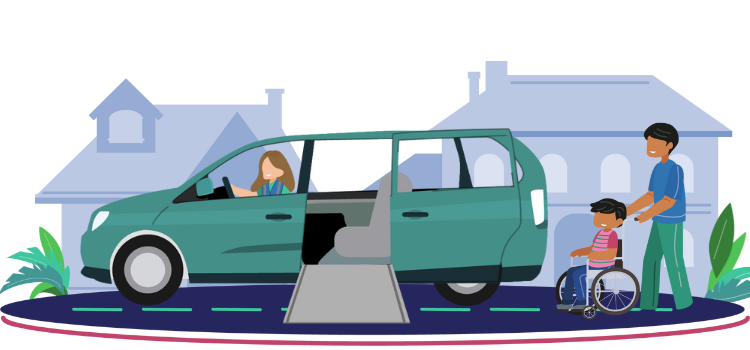This post is sponsored by EverDriven
According to the Urban Institute, educational inequity extends beyond classroom walls: it starts with inadequate transportation options for students. For the most vulnerable students, such as those experiencing homelessness, in foster care, or those with special needs, the inequality in transportation when it comes to regular school and extracurricular activities is even worse.
It is essential to modernize student transportation regulations across the country to enhance students’ well-being and safety.

Morgan Judge is the Director of Compliance, Regulation, and Policy at EverDriven. In this role, she aims to help all children receive equitable access to a quality education. She shared with us some insight into why it’s time to modernize transportation regulations.
Question: Why is it essential to modernize student/pupil transportation to include smaller capacity vehicles and their drivers?
Answer: When I think of the modernization of student transportation, I think of districts truly adapting to modern needs, down to the individual level. Alternative transportation is a direct result of that adaptation, allowing districts to get more students to school by thinking outside of the bus.
Student transportation needs have changed faster than the industry – a lot of things have changed the landscape in the last 10-20 years including school populations, school choice, chronic absenteeism, a rise in IEPs – and then there’s also the issue of bus driver shortages, or a CDL shortage. As a result of this new and constantly shifting landscape, student transportation departments need to have more flexibility with the basics – routing and vehicle size. Alternative transportation allows for that flexibility as the districts need it.
Districts, counties, and states will need to continue modernizing student transportation in their RFPs, their safety standards, and their laws and regulations to recognize smaller capacity vehicles and their drivers.
Q: School buses and school bus drivers in every state must adhere to rules and regulations and have certain inspections and maintenance schedules. Not all states regulate alternative vehicles and their drivers though. Explain how beneficial regulating alternative student transportation is for keeping students safe.
A: School buses and school bus drivers are regulated from A to Z in every state. As student transportation modernizes and alternative options become more necessary for districts that need flexibility in their transportation plans, the lack of regulation surrounding alternative transportation allows for too much variation between districts, contractors, and regulatory oversight.
As an example, most states require significant vetting for school bus drivers that goes beyond background checks and motor vehicle record checks, including physical examinations and drug and alcohol testing that is more than just a zero-tolerance policy. In states where alternative transportation isn’t regulated, drivers of alternative vehicles have no state-based threshold for physical fitness or drug and alcohol clearance. That leaves the providers of alternative transportation or school districts to determine their own standards. Though driver vetting of this sort seems like common sense, if the state lacks regulatory oversight of alternative transportation drivers, then it’s essentially being said that the physical health and mental wellbeing of a bus driver is more important than that of an individual who drives a car, even though they both transport students.
We always advocate for regulations to be right sized. Drivers who transport students for a school district in a small-capacity vehicle, a sedan, a mini-van, or an SUV, should not have to procure a commercial driver’s license (CDL), for example. They should also not have to take a course on how to drive a school bus or a commercial vehicle. They should, however, be required to be in good physical health and free of substance abuse, as well as have a good motor vehicle record, and take a course on good defensive driving. There are a number of safety standards that can be right sized for a small-capacity vehicle, but hold the same intention of school bus driver regulations – which is to keep students as safe as possible no matter what size vehicle they’re being transported in.
Q: If student transportation is deregulated across the country, what problems will families face?
A: This goes back to modernization. Everyone is comfortable with the school bus because historically we have placed faith in the government oversight of the school bus and school bus driver regulations.
The rise in alternative options should not mean that student transportation becomes deregulated, but that the regulation is modernized, or right sized, to fit the updated transportation model.
Alternative transportation is about adapting to meet the needs of the students. That adaptation can and should be done without compromising their safety just because they’re in a different vehicle.
We have seen legislative trends in several states across the country to deregulate alternative transportation by circumventing the primary regulator (typically the Dept of Education, Dept of Motor Vehicles, or Dept of Public Safety). These bills often try to exempt contractors of alternative student transportation from adhering to certain regulations due to specific business types or unique technological advancements.
For example, we’ve seen telematics be offered as a replacement for physical examinations by a medical professional or drug and alcohol testing. Telematics are an incredible tool available to the modern transportation industry, and can be used to inform businesses of driver’s daily movements, driving habits, and vehicle conditions. Telematics are a fantastic safety supplement in addition to a motor vehicle record (that is subject to ongoing monitoring), but they should not act as a replacement for physical fitness observed by a medical professional, or drug and alcohol testing requirements.
Allowing alternative student transportation to be regulated by multiple state agencies simply because of differing contractor business types is a form of deregulation that results in conflicting requirements for school districts and contractors. Though the service provided is the same, the regulations for the businesses are not. The result is varying safety requirements for the same district in the same state depending on the contractor and the ‘type’ of business they are.
This creates confusion for school districts and adds layers of complexity at the state level because there are multiple agencies now required to regulate one type of student transportation. Families, who have historical trust in the oversight of school buses, assume that the same regulations apply to the drivers of smaller vehicles, when they do not. That trust is being violated without the families even being aware.
Q: When operating in states without strong alternative student transportation regulations, how does EverDriven prioritize safety?
A: At EverDriven safety is our number one priority. We’ve been in the alternative student transportation space for almost two decades – longer than anyone else in the industry, and in that time, we’ve developed a true industry standard when it comes to the safety of students.
The EverDriven Safety Commitment prioritizes safety by requiring all drivers and vehicles that service EverDriven trips to be SafeRide certified. For vehicles, that includes a 51+ point EverDriven inspection as well as an annual 3rd party inspection. For drivers it includes things like federal, state, and local background checks, enrollment in a drug and alcohol consortium, county, state, and national criminal records check, and a sex offender registration check.
Additionally, we support the modernization of state regulations to include safety requirements for alternative student transportation. In the past three years bills in Indiana, Georgia, Maryland, Illinois, and recently California have been introduced to either establish or require the primary regulator of student transportation to establish common sense safety standards for alternative transportation at the state level.
Q: How does EverDriven help simplify the process of alternative student transportation and help families safely get their loved ones to school?
A: We’ve tried to make the entire trip as transparent as possible for all parties involved, while also keeping the student data encrypted and protected – another level of safety sometimes overlooked. That level of transparency helps to build trust and stability with the students and their families.
For the districts, we’ve built a District Portal. Districts can upload lists of students they need help transporting, providing all of their specific needs, and our teams take it from there. Once the student has been routed, and a driver and vehicle have been identified, that information is also shown in the portal so the district has visibility. They can download reports and stay apprised of students who may have repeated absences or incidents, and they can check to see where the vehicles are if someone is running late.
For parents, we have our VIP (Very Important Passenger) app. When drivers mark a student has having been picked up or dropped off in our driver app, that information goes directly to both the District Portal and the VIP app. The app then sends a notification to the parent or guardian letting them know of their child’s trip status. If a driver is running late because they’re, say, stuck in traffic, the parents have visibility into that too.
EverDriven recognizes that our clients – counties, districts, charter, and private schools throughout the country – not only need flexibility, but also the personal touch. The human element cannot be overlooked. We understand that safety starts with vetting and ends with a transparent system for both our clients and the families we serve together.
Alternative student transportation centers on adapting to and serving students and their families. That adaptation must happen, but not at the risk of student safety. Serving over 500 school districts nationwide, EverDriven transportation services are compliant with all state regulations and set the industry standards to keep our children safe while on their way to and from school. For more information, visit everdriven.com.
